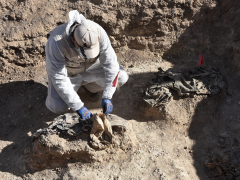The al-Khasfa site, near Iraq’s second-largest city, could contain 4,000 remains and possibly thousands more.
Published On 17 Aug 2025
Iraqi officials have begun the excavation of what is believed to be a mass grave left behind by ISIL (ISIS) during its years of carnage exacted upon the civilian population after it seized large swaths of the nation from 2014 onwards, until being vanquished three years later.
Local authorities were working alongside the judiciary, forensic investigators, the Iraqi Martyrs Foundation and the directorate of mass graves to carry out the excavation in al-Khafsa, south of the northern city of Mosul, the state-run Iraqi News Agency reported on Sunday.
The site – a sinkhole about 150 metres (nearly 500 feet) deep and 110 metres (360 ft) wide – is believed to have been the grisly scene of some of the worst massacres committed by ISIL.
Ahmad Qusay al-Asady, head of the Martyrs Foundation’s mass graves excavation department, told The Associated Press news agency that his team began work on August 9 at the request of the Nineveh province.
The operation will initially be limited to gathering visible human remains and surface evidence, while preparing for a full exhumation that officials say will require international support, al-Asady said.
The foundation will then build a database and start collecting DNA samples from families of suspected victims.
Full exhumations can only proceed once specialised assistance is secured to navigate the site’s hazards, including sulfur water and unexploded ordnance. The water may have also eroded the human remains, complicating DNA identification.
Because of the presence of these elements, al-Khafsa is “a very complicated site,” al-Asady added.
Based on unverified accounts from witnesses and families and other unofficial testimonies, authorities estimate the site could contain at least 4,00





